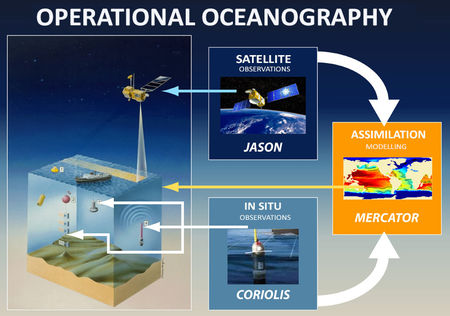The ocean plays a major role in the earth’climate. It stores, transports and exchanges large amounts of heat, water and gases, and acts as a memory of the climate system. Global ocean observations are critical to understand and forecast the earth’ climate and weather as well as for a wide range of ocean services.
A system for operational oceanography has been developed in France.
Three approaches exist from some years to monitor and forecast the ocean behavior :
- Sea-surface observation using satellite sensors,
- In situ measurements from ships, moored or drifting autonomous systems,
- Assimilation of in-situ and satellite data in an ocean circulation model.
CORIOLIS contributes to the French operational oceanography program for the in-situ observations. The 7 institutes involved in operational oceanography in France (CNES, CNRS, Ifremer, IPEV, IRD, Météo-France, Shom) decided in 2001 to joint their efforts within Coriolis in order to :
- organise and maintain data acquisition in real-time and delayed mode of in-situ measurements necessary for operational oceanography.
- set up an operational in-situ data centre,
- develop and improve the technology necessary for operational oceanography.
Its objective is to develop continuous, automatic, and permanent observation networks. The data collected will enable water properties to be mapped, such as temperature, and ocean circulation.
The importance of Coriolis is visible through the applications that are developed based on these data :
- Coriolis, Myocean and the COPERNICUS Marine Core service : COPERNICUS is a major European initiative to monitor the state of earth environment, support policy decisions and provide a wide range of services to users. MyOcean is the first project of the ocean component of COPERNICUS, the so-called COPERNICUS Marine Core Service. Coriolis coordinates the MyOcean in-situ Thematic Assembly Center and provides in-situ data needed to constrain and validate the MyOcean global and regional Modelling and Forecasting Centers
- Ocean variability inferred from in-situ data : The global ocean plays a major role in the Earth’s climate. One way of observing and understanding the Earth’s energy balance is to evaluate the average temperature change from the surface down to the deep ocean – the so called ocean heat content. Monthly gridded global temperature fields based on in-situ measurements have been used to estimate global mean heat content variations. A clear trend of the heat content during the past years has been highlighted using in-situ data.
- new autonomous platforms to observe marine ecosystems : Marine ecosystems are a key component of the Earth system. Their evolution can now be monitored and analysed thanks to biogeochemical sensors. Specifically designed for autonomous platforms , these sensors are able to measure biogeochemical parameters such as chlorophyll concentration and its vertical distribution. They have been demonstrated on Gliders and new Argo floats called PROVBIO.

